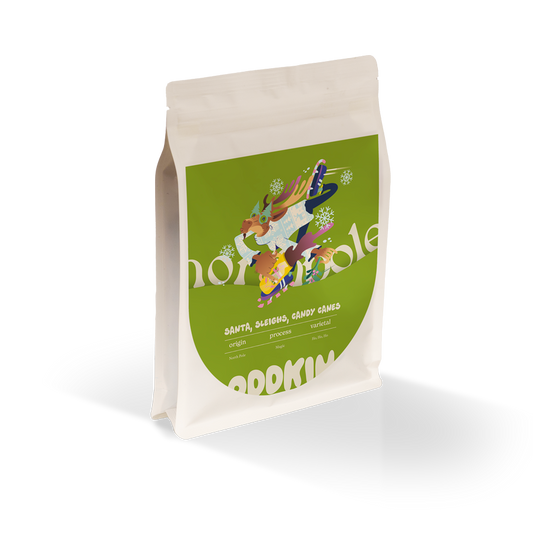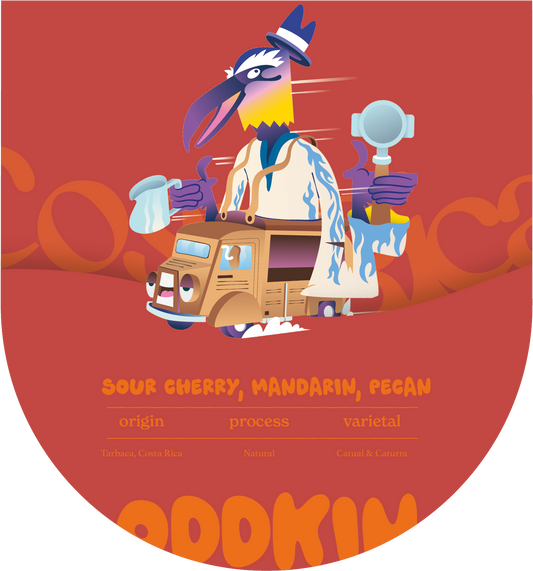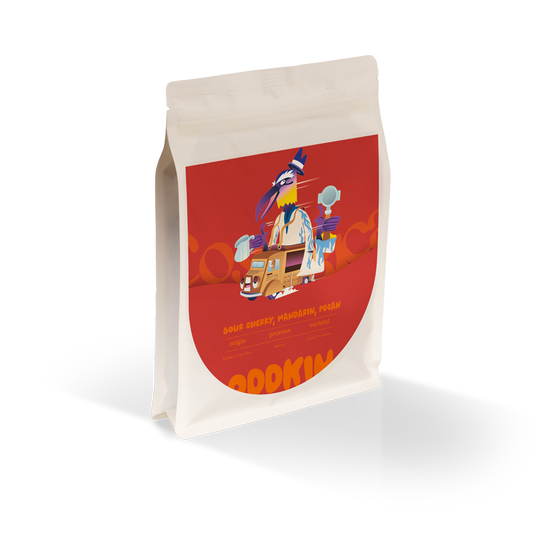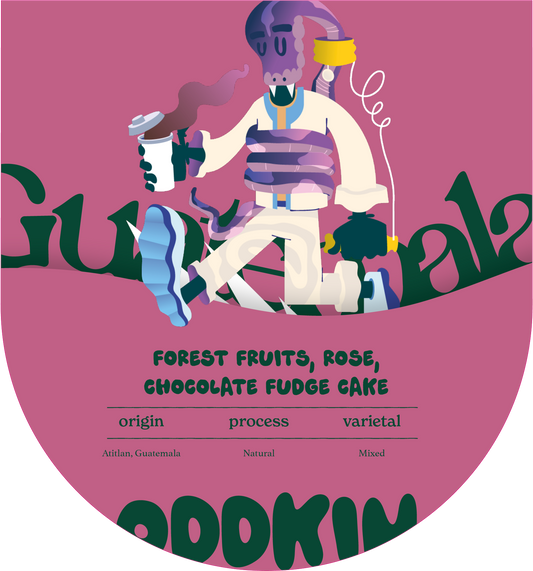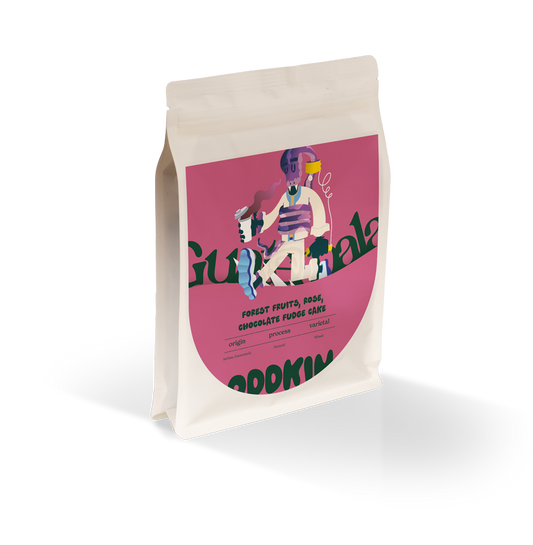An introduction to coffee processing methods
You may have sat in utter confusion whilst the baristas in your favourite coffee shop talk about natural coffees, fermentation tanks and raised beds.
Don’t be alarmed, these aren’t weird weekend activities - they’re talking about coffee processing, which is the method chosen to extract the green coffee beans from coffee cherries, ready for roasting.
This coffee processing 101 guide will give you a basic understanding of the different methods used to process coffees, and the effects these have on what you taste in your cup of morning go juice.
Processing is a huge topic for us, so we will definitely look to do some deep dives into this fascinating aspect of coffee in the future.
What is coffee processing?
Coffee beans grow in pairs inside coffee cherries on, you guessed it - coffee trees.
The wonderful coffee farmers that we work with wait until the optimum ripeness is achieved and then the harvested cherries are taken to be processed.
The aim of processing is to remove the outer skin, pulp, mucilage and parchment.
Once the green beans have been removed from the coffee cherries, they can then be laid out to dry.
After that they are inspected, cupped and scored by Q Graders and sold to green importers like Right Side, who we buy a lot of our coffees from.
How does coffee processing work?
Each coffee processing method achieves the same end result of drying the green coffee beans and removing the cherries, but through vastly different means.
The different methods used can be chosen as a result of the farmer wanting to achieve a certain cup profile, or due to logistical reasons, like how readily available water is in the region.
The different types of coffee processing methods:
There are three main types of coffee processing: washed processed coffee, natural processed coffee and honey processed coffee (which is sometimes referred to as pulped natural coffee).
The method of processing used will have a huge impact on the cup profiles tasted once the coffee is brewed.
Washed Process Coffee
Wet processed coffee is the most commonly used processing method, due to the high clarity of flavour that it produces.
Washed coffees tend to have a beautiful acidity, described as being fresh, bright and clean.
Wet processed coffee is ultimately when all outer layers have been removed from the bean before the drying process begins.
Harvested cherries are dropped into flotation tanks, where any unripe cherries that snuck into the party are swiftly ejected by the coffee processing bouncers.
A depulper machine is then used to mechanically remove the outer skin layers and at this point all that will be left is the sticky mucilage.
The coffee beans are then put into fermentation tanks for anywhere between 18-36 hours, before being washed in clean water to remove any mucilage left in place.
Finally, the washed beans are left to be dried in the sun, mostly commonly on large patios or raised drying beds.
This drying process can take anywhere from 10 - 25 days and will be dependent on the climate and desired moisture content the farmer wants to reach.
Washed processing is super consistent, which is important in order to maintain quality levels throughout the farmer’s whole harvest.
Another thing to note about washed coffees is their ‘purity’, because you are tasting the beans origin, varietal and terroir, rather than any impacts on flavour from processing.
Natural Process Coffee
Dry process, also known as unwashed or natural coffee, is the oldest method of processing coffee, due to it requiring less infrastructure and water.
Unlike washed coffees, these naturally processed coffees are dried with the coffee cherries intact, and the flavour profiles produced can be extremely exciting.
Natural coffees are full bodied, low in acidity and have the ability to really surprise you - ever tried a coffee before that tasted like a boozy blueberry yogurt?
It was probably a natural Ethiopian from somewhere in the Guji Highlands! Natural coffees can be risky and inconsistent ,due to over-fermentation, so it takes a lot of skill to get it right and achieve high scoring, speciality grade coffees.
Once harvested, the ripe coffee cherries are laid out to dry in the sun, usually on patios or raised drying beds until the desired moisture level is reached.
The cherries need to be constantly raked and turned in order to stop over-fermentation taking place. After several weeks, the coffee cherries will be dehulled to remove the dried green beans from inside.
Dry processing coffee can have huge impacts on the cup profile, and when producers get it right, the results are phenomenal.
Honey Process Coffee
We like to think of honey processed coffees as sitting somewhere between washed and natural coffees on the processing spectrum, drawing lovely elements from both methods.
The name 'honey' is due to the sticky layer of mucilage that is left on the bean during drying, and also because of the syrupy sweetness that you’ll enjoy in the cup.
Similar to washed coffees, the cherries are dropped into a flotation tank with the unripe cherries removed, before the outer skin and pulp are removed - leaving the bean covered in the sticky, honey-like mucilage.
The beans are then laid out on patios or beds to dry in the sun for two to three weeks with the climate conditions and time both affecting the type of honey coffee produced.
Higher humidity levels and therefore a longer drying time lead to black honey, whereas low humidity and faster drying times leading to red and gold honey.
If you think of this as a spectrum, the gold honey coffees will have characteristics more in line with washed coffees.
Whereas, red and black will move towards the natural cup profiles we mentioned earlier, with more fermentation taking place during the drying phase.
We love honey processed and pulped natural coffees here at Odd Kin as you get to enjoy the best of both worlds, with high levels of sweetness paired with super clear cup clarity.
The kinds of coffees you’d love to sit down and share with your old pal, Winnie The Pooh.
Sugarcane Decaffeination Process
This is our favourite way to decaffeinate coffee, due to it being both environmentally friendly and resulting in a coffee that retains all of its gloriously sweet flavours.
The coffee cherries are fully washed and then undergo the sugarcane decaffeination process, which uses fermented sugarcane liquid.
Our El Carmen decaf coffee from the El Carmen Collective in Colombia, uses water from the Navado del Ruis volcano, and natural ethyl acetate from fermented sugarcane, sourced from Palmira.
The porosity of the coffee is increased through the use of steam, which begins to break the bond between caffeine and the bean.
The bean is then submerged in the fermented sugarcane liquid, until 97% of the caffeine is removed. Following this, a final steam takes place to clean up the decaf coffee beans.
Whilst, not the only method available to decaffeinate coffee, it is the most natural and we believe it produces the highest quality of cup profile when you get round to brewing it up at home.
What is experimental coffee processing?
Experimental processed coffees are becoming increasingly popular around the world, with producers really testing their skills and knowledge to essentially invent new processing methods.
The results we’ve tried have been spectacular. Joaquin of Right Side is always experimenting with the farmers we buy from at origin, and it’s been a delight to showcase these rare coffees.
Two experimental processes that we have showcased so far on our roasting journey have been:
- Honey Glory
- Natural mystic
As an example, our La Esperanza coffee from Luis Balladarez in Nicaragua last year was a natural mystic.
During this process the whole cherries are fermented underwater, with different resting periods to achieve cleaner and more defined notes. Following this, the whole cherries are left on raised beds under shade to dry for around 25 days.
We can’t wait for this coffee to come back on to our roaster soon, alongside a number of other exciting experimental numbers. Watch this space!
How does the processing method affect coffee?
The processing method used will certainly affect the taste of your brewed coffee. If you’re up for a clean, bright cup choose a washed coffee; if you’re looking for a boozy, funky coffee full of body then go natural; or if you can’t decide hit up a honey as it’ll sit somewhere nicely between the two!
How have Odd Kin's coffee beans been processed?
When we are sourcing our coffees and building our rosta, we view it the same as creating a beautiful dish of food or menu for Odd Shop.
We are looking for balance, intrigue, consistency and the odd surprise! What you’ll find here is a wide range throughout the year, all of which showcase a variety of different coffee processing methods.
We know that not everyone likes crazy, in your face naturals like our Nicaraguan Mozonte or Ethiopian Mensur, so we’ve always got some super easy drinking, mellow crowd pleasers like our seminal Colombian Aguas Claras.
We’ve always wanted this coffee roasters to be accessible for everyone, so we try to balance our coffee offering throughout the year.
Let us know on Instagram what your favourite coffee from us has been so far!



